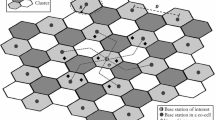Abstract
This paper analyzes the uplink behavior of the multicode and variable spreading factor DS-CDMA systems that accommodate users with different transmission rate requirements in a multicell mobile radio system. It takes into account the possibility of a portable to choose the least interfered among N c nearest base stations, imperfect power control on slow signal fluctuations resulting from shadowing and random location of the users. System capacity is determined analytically, employing two distinct approximations featuring low computational costs, and by simulation. It is shown that having the portable controlled by the least interfered base produces a remarkable improvement on the performance of both classes of users and that either architecture (multicode or variable spreading factor) can favor voice or data applications through a suitable tuning of system parameters. Moreover, the simulation approach allows to assess the accuracy of the analytical approximations for an interesting range of system parameters.
Similar content being viewed by others
REFERENCES
D. Ayyagari and A. Ephremides, Cellular Multicode CDMA Capacity for Integrated (Voice and Data) Services, IEEE. J. Select. Areas Commun., pp. 928–938, Vol. 17, No. 5, May 1999.
P.-R. Chang and C.-F. Lin, Design of Spread Spectrum Multicode CDMA Transport Architecture for Multimedia Services, IEEE J. Select. Areas Commun., pp. 99–111, Vol. 18, No. 1, January 2000.
W. Choi and J. Y. Kim, Forward-link Capacity of a DS/CDMA System with Mixed Multirate Sources, IEEE Trans. Veh. Technol., pp. 737–749, Vol. 50, No. 3, May 2001.
R. Zhang, T. T. Tjhung, H. B. Zhang, and P. He, BER Performance Comparison of Single Code and Multicode DS/CDMA Channelization Schemes for High Rate Data Transmission, IEEE Commun. Lett., pp. 67–69, Vol. 5, No. 2, February 2001.
M. Casoni, G. Immovilli, M. L. Merani, Admission Control in T/CDMA Systems Supporting Voice and Data Applications, IEEE Trans. Wireless Commun., pp. 540–548, Vol. 1, No. 3, July 2002.
P. Bender, P. Black, M. Grob, R. Padovani, N. Sindhushayana, and A. Viterbi, CDMA/HDR: A Bandwidth-Efficient High-Speed Wireless Data Service for Nomadic Users, IEEE Commun. Mag., pp. 70–77, Vol. 38, No. 7, July 2000.
M. Haardt, A. Klein, R. Koehn, S. Oestreich, M. Purat, V. Sommer, and T. Ulrich, The TD-CDMA Based UTRA TDD Mode, IEEE J. Select. Areas Commun., Vol. 18, pp. 1375–1385, August 2000.
3GPP TS25.101 V3.4.1 3rd Generation Partnership Project; Technical Specification Group Radio Access Networks; UE Radio Transmission and Reception (FDD).
J. M. Holtzman, A Simple, Accurate Method to Calculate Spread-Spectrum Multiple-Access Error Probabilities, IEEE Trans. Commun., pp. 461–464, Vol. 40, No. 3, March 1992.
G. Immovilli, M. L. Merani and M. K. Shahin, A Simplified Approach to the Performance Evaluation of FDMA-CDMA Systems, ACM Wireless Networks, pp. 1501–1504, Vol. 3, No. 1, 1997.
A. J. Viterbi and A. M. Viterbi, Erlang Capacity of a Power Controlled CDMA System, IEEE J. Select. Areas. Commun., Vol. 11, pp. 892–899, August 1993.
A. J. Viterbi, A. M. Viterbi, and E. Zehavi, Other-cell Interference in cellular power-controlled CDMA, IEEE Trans. Commun., pp. 1501–1504, Vol. 42, No. 2/3/4, February/March/April 1994.
R. K. Morrow, Accurate CDMA BER Calculations with Low Computational Complexity, IEEE Trans. Commun., pp. 1413–1417, Vol. 46, No. 11, November 1998.
Author information
Authors and Affiliations
Rights and permissions
About this article
Cite this article
Malavasi, S., Luisa Merani, M. Alternative DS-CDMA Architectures for Voice/Data Applications with Best Base Station Assignment. International Journal of Wireless Information Networks 10, 87–100 (2003). https://doi.org/10.1023/A:1025313510846
Issue Date:
DOI: https://doi.org/10.1023/A:1025313510846




